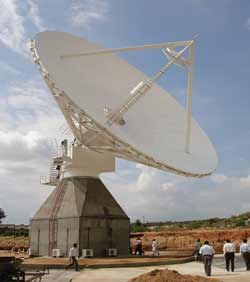Chandrayaan: In commercial orbit
22 Oct 2008
New Delhi: The Chandrayaan-I mission is set to be a watershed in India's space programme in more ways than one. Not only do the technical challenges associated with the programme serve to enhance the country's capabilities in launching and manufacturing satellites, but sharpen its defence capabilities as well. The mission, coupled with Chandrayaan-2, will act as important precursor's to the launch of an Indian manned space mission by 2015, and a manned lunar mission in 2020.
 Even as these important programmes loom ahead, what is of immediate interest globally is the commercial viability of the Indian space facilities and expertise. The Chandrayaan mission is now set to firm up the foothold that India has already achieved in the highly competitive space launch and fabrication market.
Even as these important programmes loom ahead, what is of immediate interest globally is the commercial viability of the Indian space facilities and expertise. The Chandrayaan mission is now set to firm up the foothold that India has already achieved in the highly competitive space launch and fabrication market.
Budgeted at a measly $80 million, the Chandrayaan-1 mission is almost half the cost of China's Chang'e 1 mission ($187 million) and about a sixth of Japan's Selene lunar programme ($480 million) - both launched in 2007.
Interestingly, though the Chinese mission costs are double, the number of payloads carried by it are half that of Chnadrayaan.
India began its space programme in 1963, and over a period of decades has developed a remarkably sturdy space programme of the highest sophistication, through which it builds its own satellites and launch vehicles and is dependent on foreign agencies for virtually nothing.
Analysts point out that India benefits from low cost technical manpower and a high degree of indigenisation of systems and components. ISRO builds rockets and remote sensing satellites at a cost at least 30 per cent lower than that of rockets and satellites built by NASA and the European Space Agency (ESA).
India's first commercial launch took place last year April when it sent an Italian satellite into orbit. In January this year it launched a sophisticated Israeli spy satellite into orbit.
PSLV The workhorse of the ISRO's launch fleet, the Chandrayaan mission is the 14th flight of the PSLV. Since 1993 the PSLV has put 29 satellites into a variety of orbits. For this launch the vehicle was modified with larger strap-on motors aimed at providing it with higher payload capability.
The workhorse of the ISRO's launch fleet, the Chandrayaan mission is the 14th flight of the PSLV. Since 1993 the PSLV has put 29 satellites into a variety of orbits. For this launch the vehicle was modified with larger strap-on motors aimed at providing it with higher payload capability.
According to ISRO sources, even as the global standard of launching payloads is $30,000 per kg, ISRO's Polar Satellite Launch Vehicle (PSLV) has a record of launching foreign satellites between $8,000 and $10,000 per kg of payload, making it extremely cost-competitive.
Last year, the PSLV put Indonesia's LAPAN-TubSat (60 kg) and Argentina's 6-kg nano-satellite called Nano PehuenSat-1 into orbit at just under $10,000 per kg of payload. This year, a PSLV launch vehicle put 10 satellites into orbit at one go, a feat virtually unmatched by any other nation, except Russia which has put a slightly lesser number of satellites into orbit at one go.
For the record, NASA's 1966 Apollo programme put men on the moon at a cost of about $22.7 billion, which at current prices would total approximately $135 billion.
Satellites
Apart from launching satellites, India is currently competing with global majors such as EADS, Mitsui, Motorola, Raytheon and Boeing in the fabrication market as well, where it is targeting revenues of $60 million from outsourced satellite manufacturing alone.
ISRO recently manufactured and shipped satellites for two major European companies. The first of these is a telecom satellite, W2M, for Paris-based Eutelsat Communications. The order was sub-contracted to India from European Aeronautic Defence and Space Company's subsidiary, EADS Astrium, which builds telecom, military and weather satellites.
Another recent contract involves the building of a broadcast satellite for a broadcast company, the UK-based Avanti Screen Media. ISRO's commercial marketing arm Antrix confirms has organisation has more such deals in the pipeline, though it is not in a position to reveal details immediately.
Deep space facilities
The mission also opens the opportunity for "space process outsourcing" for the country. The Chandrayaan-1 mission led to the development of a 32-metre as well as an 18-mtere dish antenna, which will tap telemetry signals emanating from deep space. The antennas, which can listen into radio signals travelling in space millions of miles away, have been installed at Bylalu village near Bangalore.
The facility, with its powerful antenna, is the nearest to the equator and will be most useful for deep space missions.
ISRO telemetry division officials said that they expect that these antennas would be hired by NASA or European space agencies for their deep space missions.
The Bylalu facility is a potential money earner and this can be gauged from the fact that NASA typically charges $25,000 (Rs12.2 lakh) an hour for receiving data from missions that do not carry its instruments. Chandrayaan is safe as it carries not one but two NASA payloads.
The Rs100-crore Bylalu deep space network can receive data for 12 hours while the spacecraft faces the subcontinent. It can also store onboard data that it collects for more than a day, before it beams it to earth.
Commercial considerations apart, Chandrayaan-1 is also about national pride and India's standing in the international community. The mission, and ISRO's commercial programme, lets the world know that technologically India has well and truly arrived and is one part of the Asian triumvirate along with Japan and China.






























